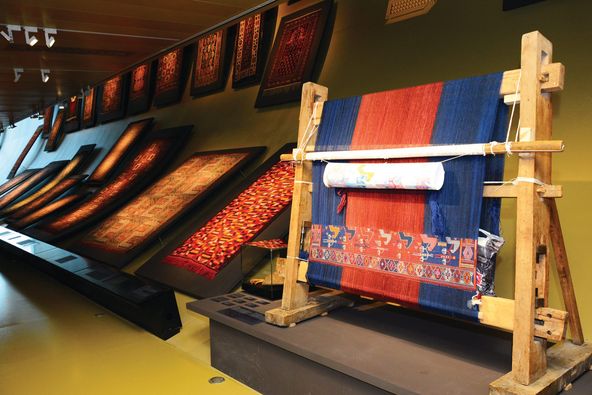By Togrul Mashalla
Carpet weaving represents one of the most ancient types of Azerbaijan’s applied and decorative arts. It is not by chance that, in 2010, traditional carper weaving of Azerbaijan was included in the UNESCO representative list of intangible cultural heritage of humanity. Azerbaijan’s carpet weaving tradition can be traced back to the Bronze Age, according to historic records. It was back then that carpets had become an integral part of the everyday life of this country’s inhabitants. Eventually, carpets began to embody the artistic conception, ideas, imaginations, aesthetics, harmony, visual clarity and entire color range of human environment.
The first written mention of Azerbaijani – at that time they were Median – carpets was made by ancient Greek scientists. Thus, Xenophon, the ancient Greek philosopher that lived in V century B.C., mentioned that Persians had learnt how to make and use carpets from Medians, while the “father of history” Herodotus had described the process that was employed to manufacture vegetable dyes applied in the making of Caucasian carpets. It was back in VI century B.C. that historic and literary sources began to make conspicuous mention of Azerbaijani carpets. Abundant and valuable information about Azerbaijani carpets and carpet weaving practice is given by Moses Kalankatuatsi, a 7th century Albanian historian, and such Arab writers as Masudi, Tabari, Al-Mukaddasi, Ibn Haikal and Al-Istakhri (IX-X centuries B.C.). Sometime later, in late medieval period, the Azerbaijani carpets were known as a commodity that was exported into Europe. As a sign of luxury, Azerbaijani carpets were, for example, depicted by Jan van Eyck on his painting titled ‘Madonna Kaninchen’ (14th century), seen on Pinturicchio’s ‘The Scenes from the Life of Pius II’ and H.Memling’s triptych dedicated to Virgin Mary.
In the 16th century, the art of carpet weaving reached its vertex. This had coincided with the period when the state of Safavids was being established. The rulers of the foregoing kingdom, especially Shah Ismail I (Hatayi), encouraged development of art, including the popular folk art of carpet making.
In terms of their ornaments and decorations, Azerbaijani carpets differ from each other based on their type and location where they were made. There were several local carpet weaving schools that had mutually influenced each other to mutual enrichment. Some of them are known for their inherently complex geometric patterns that represent conceptual bodies of men and animals, and are aligned along a straight axe found in the middle of multiangular and/or stellular medallion. Other types of carpets are characteristic of diverse floral decorations with abundant variations reflecting flower-shaped motifs. J.Vea, a noted American collector and fine art expert, believes that the pattern of decorations Azerbaijani carpets have are notable for “an entwinement of Turkish, Persian and Asian traditions and influences, as well as inherent carpet weaving features derived from North-Western tribes of Iran.”
Seven carpet making schools have been acknowledged up to date:
1) Catching one’s eye with a complex décor and subtle design, the carpet series titled ‘Hilli Buta,’ ‘Novhany’ and ‘Fatmayi’ belong to the Baku school of carpet weaving. Baku carpets exhibit soft and intense colors; they bear original artistic features, and reflect subtle images. They predominantly use the pattern called ‘gel,’ or a geometrically shaped oval, and plant patterns with curvatures. Blue color is used to fill out spaces in between. The use of red and yellow is rather rare.
2) The Guba carpets include ‘Pirabedil,’ ‘Gimil’ and ‘Sirt-Chichi’ types that impress by their fine fabric, tiny vegetative design, and tightly fitted bright colors. Vegetative and, sometimes, zoomorphic motifs comprise geometric shapes and predominantly represent the major kind of decoration used in these carpets.
3) The Shirvan carpets called ‘Mughan,’ ‘Tabistan’ and ‘Shilyan’ gravitate more towards ancient compositions that emanate a strict rhythmic idea with tranquil and monumental coloration. The Shirvan carpet series, comprising complex pictures, are known since medieval time. They were most frequently depicted by European painters of 14-15 century.The Ganja and Gazah schools of carpet weaving are somewhat similar. The carpets of these schools – ‘Fahraly,’ ‘Shyhli’ and ‘Borchaly’ – are noted for their brashy wool with a velvety play of colors depicting large stylized and simple geometry of structure. These carpet weaving schools apply harmonious coloring that requires a small amount of dye.
4) The Garabag carpets include ‘Hanlyg,’ ‘Malibeili’ and ‘Lyampa’ and reflect deftly made compositions, ingenuity of imagination and a range of vivid colors. Very popular in Garabag were series of carpets that were used for interior decorations in homes. These carpets are known for the exceeding richness of their graphics and colors that notably reflect the most subtle nuances of Garabag’s nature. Their intermediate sections are filled with red dye, according to ancient tradition.
5) The Tebriz carpets – ‘Sarabi,’ ‘Afshan’ and ‘Lechek Turundzh’ – discover a combination of interwoven ornamentation with round and spiral-shaped decor that depict the image of the world’s inviolable harmony. Tebriz School of carpet weaving is the oldest and most renowned in Azerbaijan. Its development culminated in 11-12th centuries; while in 13-14th centuries it adopted artistic peculiarities from the Tebriz School of miniature. In the 16-17th centuries it attained unto even higher levels of development. Both pile and non-pile carpets of this school are known for their peculiar fine art patterns, balance of colors and diversity of decorative arts. It is Tebriz type of carpets that, amid different kinds of Azerbaijani carpets, are noted for their rich ornamentation and vivid range of colors.
Geometric patterns used in Baku, Guba, Gazah and Ganja style carpets predominantly include gammadion and eight pointed star. Swastika is characteristic of the heaven’s polytheistic heart that emanates contorted spiral beams. Placed in the middle of the carpet, the eight pointed star is surrounded with symbolic rhombic- and square-shaped figures. Resulting from the influence of Tebriz School, the fringe areas of carpets produced by other schools have adopted patterns that symbolize plant world. Azerbaijan’s carpets often depict various Muslim symbols: the hand of Fatima, beshbarmak (symbolic of the five commandments of Islam), and architectural element called ‘mihrab’ (a prayer niche in the qibla wall, i.e. that facing Makkah, of a mosque). The ‘Tree of Life’ is the most frequently used spriggy pattern applied in, mostly Tebriz, carpets that occasionally also depict orchards infested with scores of animal species and plant types. In Azerbaijan’s art of carpet weaving, plant-shaped ornamentations played an important role due to the influence of Tebriz School. Tebriz and Shirvan carpets often portray pomegranate. Its ability to grow in harsh and dry soils caused people, since ancient times, to treat it as a miracle of nature; it also played an important role in Zoroastrianism. The deftness of carpet weavers was amply told by a pomegranate split in two, where one could distinctly see the fruit’s seeds. As this motif would gradually develop, Tebriz carpets began to depict a ripened fruit of pomegranate, which was titled “the Flower of Shah Abbas.”
Of all birds depicted by Azerbaijan’s carpets, eagle and peacock were considered most popular. The eagle, as depicted in palatial (Tebriz) types of carpets, is symbolic of might and royal dignity, but an eye of a peacock was believed to be able to chase trouble. Some carpets depicted goats and rams, which evidenced the carpet weaver’s nomadic ancestors. Beside other plants and animals, one could find carpets depict even some fantastic creatures such as dragons. Such depiction would often be considered a lucky charm, and was predominantly used throughout the span of several centuries (XVII-XIX). Meanwhile, Azerbaijan’s narrative carpets have had a longer history of existence than that of decorative carpets. Their narratives would come from real life, nature and historic developments. The ‘Ovchulug’ (hunting) carpets are believed to be most ancient. The hunting carpets are known to be one most enduring type in Azerbaijan’s decorative art. Also, there are renowned carpets that portray various motifs from oriental literature. Especially popular are narratives derived from the writings of Nizami Ganjavi, the great Azerbaijani poet and philosopher.
Azerbaijan’s carpets (XVI-XIX) are also represented in Hermitage; along with other collections they are exhibited in New-York’s Metropolitan Museum of Art as well as in museums of UK, Germany, Turkey (the most ancient carpet dates back to the 13th century), Vatican and other cities of the world. These collections include thousands of pile and non-pile types of carpets woven by Azerbaijan’s carpet weaving enterprises. Amid the many carpets found in various museums of the world, there is one rug that was woven at the order of Shah Tahmasib in Tebriz, 1539, for the mosque of Ardebil. The carpet’s scientific name is “Sheikh Safi,” and it is exhibited in the Islamic Middle East section of London’s Victoria and Albert Museum.
In order to provide for an effective and ample showcasing of Azerbaijan’s carpets and considering they are an integral part of Azerbaijan’s household and everyday life, a decision was made in 2008 to construct a separate building for the carpet museum. The museum construction was launched by the order of Azerbaijan’s President Ilham Aliyev. Also, it was supported by the Heydar Aliyev Foundation and UNESCO.
On 26 August 2014, the unique Carpet Museum building was officially opened to the public. The Carpet Museum was designed by Franz Yanz, an Austrian Architect, which endowed the building with an original style. His building reminds a rolled carpet, and it was erected in one of the most favorite promenades of Baku, the Seaside Boulevard.
At the moment, the museum’s holdings and rooms preserve more than 13,3 thousand exhibits and items (carpets, metal items, fabric, clothes and other items of people’s daily life and applied arts). These include valuable historic collections and pieces of art that tell about Azerbaijan’s age-old history. The museum preserves such archeological memorials as ceramic and bronze items, delft ware and national clothes dating back to the 19th century, as well as metalwork, woodwork, glasswork, jewelry and weapons. Along with a large number of diverse carpets (halcha, hali, est hali, gebe, palas, shedde, varni, sumah, zili), the museum collection includes various tapestries such as hurzhun, chul, mafrash, etc.
One antique item in the museum is a 17th century fragment of Tebriz ‘Ovchulug’ rug and ‘Hila Afshan’ carpet that was woven in the 18th century in Amirajan settlement (former Hila). One can also find family antiquities in the museum, i.e. valuables that were donated to the museum (hurzhun, chulu). The museum collection also includes rugs that were brought from Shusha carpet museum (about 600 carpets and other items) because they could be destroyed. Currently, the carpet museum is still collecting Azerbaijani rugs. Some collectors continue donating carpets to the museum. In June 2013, Beverly Shilts, the spouse of a member of Chicago Oriental Rug and Textile Society by the name of H.Shilts, handed two Azerbaijani carpets over to the museum: ‘Dragon Rug’ of Garabag, late 17th century and Salyan-Hila type of Shirvan carpet, 19th century. They both came from H.Shilts’ personal rug collection. Talking about museum rugs, it should be noted that they include all schools of Azerbaijan’s carpet weaving tradition as well as rugs that date back to previous centuries. The museum is completely equipped to ensure preservation and conservation of rugs and tapestries.
Carpets have become an integral part of Azerbaijan’s image in the international arena making it merely impossible to imagine Azerbaijan without the fascinating and unmatched beauty of the country’s carpets.








